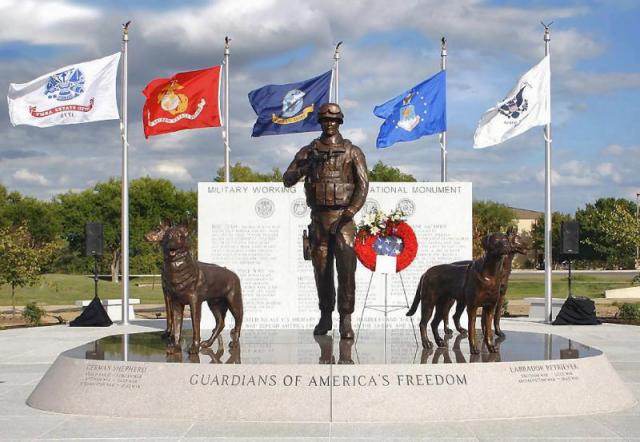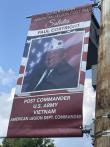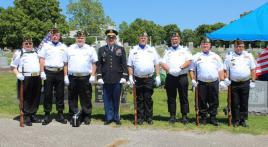Almost a half-century after his service, John Burnam saw the Military Working Dog Teams National Monument dedicated. He learned about their work firsthand during his second tour in Vietnam, when he served as a scout-dog handler with the Army.
“I knew what it was like to face the enemy but I didn’t know what it was like to take a dog out on patrol,” he said.
Burnam learned to watch their ears, the skin on their backs, listen to their breath, watch if their mouths closed because they'd smelled something ominous. With a dog on a leash and a bodyguard near him - providing eyes for Burnam because his eyes were on Clipper, his German shepherd - they'd head out in front of the patrol through the jungle. He also handled two other military dogs, Timber and Hans.
“Their instincts are much greater than a human's ... You train yourself on what the dog already knows,” Burnam said. "Alerts can be extremely close and very dangerous. Sometimes when that dog gets an alert, he’ll stop dead in his tracks and you’ll get down."
When he returned from combat, like many Vietnam veterans, he kept his military experiences private.
“I wasn’t a very popular guy on the street if I started telling stories,” he said.
But after unexpectedly reuniting in 1991 with a friend from his first tour of duty, Burnam began writing his war stories down. What started as a difficult task soon compelled him. The stories, the details, the memories poured out.
"This story just took over my life."
After years of pushing from family and friends, Burnam self-published these stories in a book. At one of the signings for his book, a reader asked him why there wasn't a national monument for these dogs.
This question would spark a quest decades in the making.
"I wasn't really sure what I was going after, except for this term 'national monument for dogs,'" Burnam said. That phrase took him to Washington to find out how national monuments get built. He found out it would require legislation, which also meant a congressman or senator to draft and sponsor it.
He reached out to politicians, and during his research found that dogs had served in every U.S. war since World War II including today, pressing this as part of his argument. He received a tired reply: "I'll vote for it when it reaches the floor."
Finally, in 2007, “after a lot of knocking on a lot of doors,” Burnam met Rep. Walter Jones, R-N.C., who agreed to sponsor the bill.
“From that point on, it was on,” Burnam said. In 2007, the legislation was submitted. In 2008 President George W. Bush signed it into law, and in 2009 President Barack Obama put Burnam's foundation in charge of managing it, he said.
Now the real work began. What would the monument look like? How much would it cost? Who would ante up the money?
After coming up with an initial design and an in-depth cost analysis, Burnam estimated the monument would take $2 million to create (and as a national monument, that price tag doesn't account for the land, which was free, of course). Working through the foundation he established to make the monument, he and his team secured the money at first slowly, through donations from private citizens and small organizations trickling in. Then, as a break, Natural Balance Pet Foods gave about $900,000, and Maddie's Fund donated $1 million. PETCO also stepped in with funds.
He selected artist Paula Slater to sculpt the bronze figures - 1.5 times life-size - of the four dogs and soldier represented.
Many dog breeds have served over the years, "but you couldn’t have Bo Peep and their sheep up on this pedestal," Burnam joked. Ultimately, four dogs were chosen: the Doberman for its service in the Pacific Theater during World War II, the German shepherd for its wide service in every war since World War II, the Labrador retriever for its service in every war since Vietnam, and the Belgian Malinois for its service since the wars in the Gulf, Burnam said. The dogs are "standard look in their regal position of power, restraint and alertness ... fanned out in front of the handler."
That soldier is "today's dog handler," with modern equipment and uniform. "He will represent all the dog handlers from today and all the dog handlers that came before him," Burnam said.
A granite wall behind details the history of military working dogs. Burnam wrote the history and said that part of the project was especially daunting: "What kind of story do you tell that will last a thousand years? ... I'm not that kind of author." It tells "what a dog does in combat and their value to our country," and recognizes veterinarians', the Department of Defense's and industry's contributions to dog teams.
A quote from Will Rogers graces the wall to sum up that bond between human and this animal: "If there are no dogs in heaven, then when I die I want to go where they went."
The back of that wall has laser-etched photographs illustrating dog and dog handlers' service since World War II. Five service flags fly, and eight benches allow visitors to relax and reflect.
But the monument isn't just for the people who visit. In honor of military working dogs, the monument is canine-friendly.
"I wanted something special for the dogs," Burnam said. Possibly the most original aspect of this national monument is its "Not Forgotten Fountain," a working bronze drinking fountain for dogs, with a soldier pouring water from his canteen into his helmet, dog by his side. "It's a very, very powerful image for the dogs that we left."
After years of work - at least six since the legislation was sponsored - the Military Working Dog Teams National Monument was dedicated and opened to the public in October 2013 at Lackland Air Force Base in San Antonio.
Burnam said the task required the help of many, and "this passion so strong that you can’t give up."
"It took a lot from me, but I gave a lot to it and I reaped a lot of benefit from the fact I accomplished something never done ... I was doing this for my dogs and for all the other dogs."
Through the training, the specific duties required and the battlefield chances, "that bonding relationship that you have with the animal" remains the same, Burnam said. "They were invaluable in saving American lives."
Photo from John Burnam Monument Foundation
For more information about the monument, click here: http://www.jbmf.us/index.aspx




